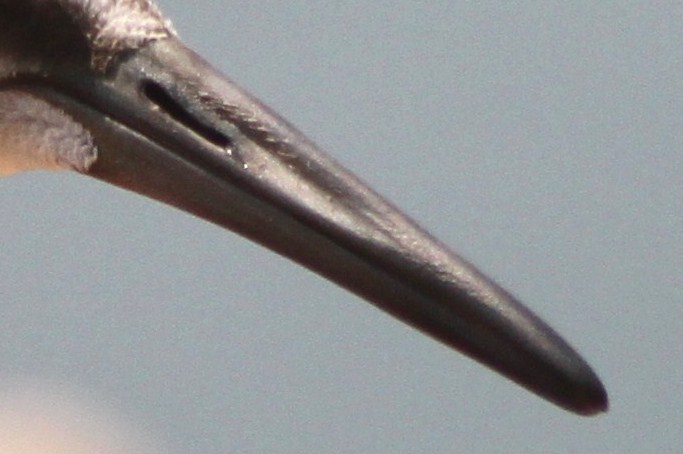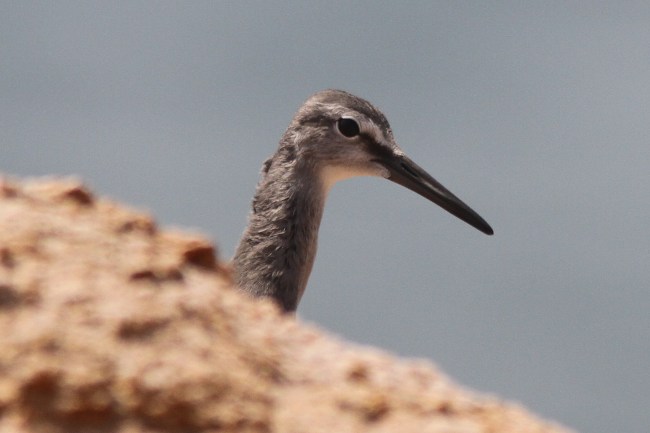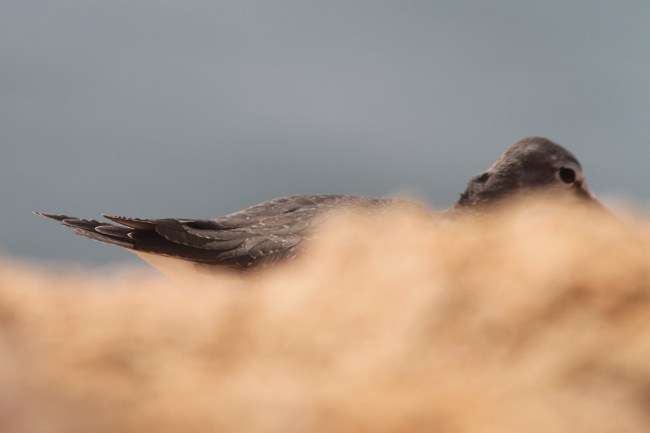As mentioned on the Po Toi forum, this tattler was seen 16 September. On seeing the photos there was some question as to the identity per Richard's comments.
I have sought some comments from oversees experts and received this response from Robert Iglis who has an excellent online essay on ID of tattlers,
http://users.tpg.com.au/inglisrc/html/id_wandering_tattler.html. Thanks very much to Robert for these detailed comments.
I am feeling confident in saying that your tattler is a juvenile Grey-tailed Tattler. Sorry about that.
There are several reasons I say that but the real 'clincher' is the white spots on the upper body feathers. These are edge-spots and fringes. There is not a huge difference in this between the juveniles of the two species but it is enough to be noticeable. The spots and fringes on the Wandering Tattler juvenile are barely noticeable compared to those of the juvenile Grey-tailed Tattler.
In your images the spots are most obvious in image tattler2.jpg but can also be seen in image tattler3.jpg. Compare those images with my attached images IMG_2712.jpg and IMG_2712_crop_flank.jpg. If you have larger images of your tattler you may be able to see the spots and fringes more clearly. With the juvenile Wandering Tattler you have to look carefully to see the spots and fringes but they stand out much more on the juvenile Grey-tailed juveniles.
The nasal groove on your tattler reaches to about the mid-point of the bill which is about typical for Grey-tailed Tattlers. See my attached image IMG_21712_crop_bill.jpg. I have marked the extent of the obvious part of the nasal groove on that bird but it probably really extends a couple of millimetres further towards the tip of the bill. That is about typical for Wandering Tattlers.
The amount of primary extension past the tail is a bit of a trap, really. It can be deceiving when there is wear and/or moult happening to the tail feathers. Many Grey-tailed Tattlers will have some extension of the primaries past the tail. The thing to really try to look for is the number of primary tips exposed past the tertials. See my attached image IMG_2712_crop_primaries.jpg. It can be hard to see in the field so photos are the best way to see it. Assuming the feathers are in good condition, Grey-tailed Tattlers only normally have a maximum of 4 primary tips exposed past the tertials; Wandering Tattlers normally have 5 primary tips exposed past the tertials. The problem with counting the primary tips is that, for both species, P10 (the outermost one) can often be hidden by P9. It often requires careful examination of good images to actually see P10. In your image tattler2.jpg you can see 5 primaries but only 4 appear to be extending past the tertials. In that photo P10 is almost concealed by P9. Image tattler3.jpg seems to show the same thing. If you have larger versions of those images or other images which show the primaries clearer you might be able to verify that.
Your tattler appears to have a much more extensive pale area from the chin onto the upper chest than is normal for a Juvenile Wandering Tattler.
The flank on a Wandering Tattler would show more dark plumage on the flank below the folded wing if it was a Wandering Tattler even though your tattler has a slightly different stance to the one in my attached image.
So, I would be sure your tattler is a Juvenile Grey-tailed.
It is interesting that, so far, there are no substantiated records of Wandering Tattlers using the East Asian-Australasian flyway considering that some Wandering Tattlers breed in eastern Siberia. Most Wandering Tattlers breed in Alaska and NW Canada and migrate to California and western Mexico. I don't think anyone really knows what route Wandering Tattlers take to get to Australia but it is assumed they come across from California/Mexico via some of the Pacific Ocean islands to NE Australia. However, some of the adults are very worn when they arrive here which could indicate they may do the trip in one hop. There are a few records now and then of Wandering Tattlers in the top end of the Northern Territory but it is a mystery as to how they get there. No Wandering Tattlers have ever been recorded in Western Australia but large numbers of Grey-tailed Tattlers pass through there every year.
It is safe to say this bird won't add Grey-tailed Tattler to the HK list but can be a useful reference for the future. Will post his photos soon.










